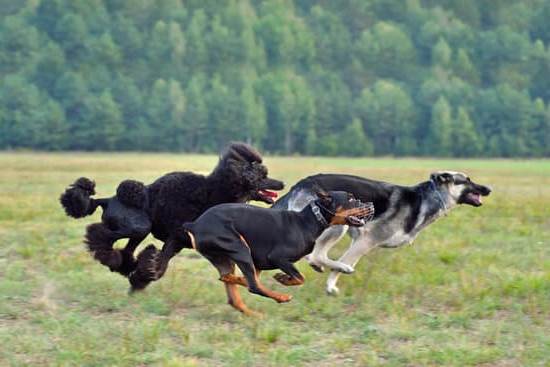Are you interested in learning how to train your dog to fetch the paper? Teaching your furry friend this impressive skill not only adds a touch of novelty to their daily routine but also brings practical benefits to your household. In this article, we will explore the various advantages of teaching your dog to fetch the paper and provide you with a comprehensive guide on how to successfully achieve this.
Choosing the right breed is crucial when it comes to training your dog for specific tasks, including fetching. We will discuss the best breed options for mastering fetching skills, taking into account factors such as size, energy levels, and natural instincts. Understanding your dog’s innate behaviors and drives related to fetching is also fundamental in tailoring your training approach effectively.
In our step-by-step guide, we will walk you through the process of teaching your dog to fetch the paper, offering practical tips for reinforcing the behavior and troubleshooting common issues that may arise during training. Additionally, we will delve into ways of making fetching an engaging activity for your dog, along with practicing and perfecting the routine in various environments. Stay tuned for our top recommended training aids and tools for achieving fetching success with your beloved pet.
Choosing the Right Dog Breed for Fetching Tasks
When it comes to teaching your dog to fetch the paper, choosing the right breed can make a significant difference in the success of this training. While any dog can be trained to fetch, some breeds naturally excel at this task due to their instincts and physical abilities.
Consider Retrievers and Sporting Breeds
Dogs that were bred for hunting and retrieving tasks are often the most successful at learning how to retrieve objects such as newspapers. Breeds like Labrador Retrievers, Golden Retrievers, and Spaniels are known for their strong retrieving instincts and love for carrying objects in their mouths. These breeds are often quick learners when it comes to fetching tasks.
Avoiding Breeds With Physical Limitations
While any dog can be trained to fetch, it’s important to consider your dog’s physical abilities when choosing a breed for fetching tasks. Breeds with short muzzles or brachycephalic breeds may struggle with holding onto larger objects like newspapers due to their facial structure. Similarly, smaller toy breeds may not have the strength or size to carry a newspaper over longer distances.
Assessing Individual Dogs Within a Breed
It’s important to note that every dog is unique, so even within a breed known for its fetching abilities, individual dogs may vary in their enthusiasm or skills for fetching objects. When choosing a dog for fetching tasks, consider your dog’s personality, energy level, and natural behaviors rather than solely relying on breed characteristics.
Understanding Your Dog’s Natural Instincts for Fetching
Dogs have been known as loyal and obedient companions to humans for centuries. One of the natural instincts that dogs possess is the desire to fetch objects, which can be traced back to their ancestors’ hunting behavior. Understanding this instinct is crucial when it comes to training your dog to fetch the paper or any other object.
Dogs have a strong prey drive, which makes them inclined to chase after moving objects. This natural instinct can be harnessed and developed into a game of fetch, where the dog retrieves an object and brings it back to its owner. By understanding this inherent drive in dogs, you can effectively train your canine companion to perform fetching tasks with enthusiasm and focus.
When teaching your dog to fetch the paper, it’s important to tap into their innate desire to please their owner. Dogs thrive on positive reinforcement, so incorporating rewards such as treats, praise, and playtime can help reinforce the behavior of fetching the paper. By using these natural instincts and positive reinforcement techniques, you can effectively train your dog to eagerly retrieve the newspaper each morning.
As you begin training your dog to fetch the paper, take note of their individual instincts and preferences. Some dogs may naturally gravitate towards fetching activities due to their breed characteristics or personal inclinations. By recognizing and catering to your dog’s specific predispositions for fetching, you can tailor your training approach for optimal success in teaching them how to fetch the paper on a regular basis.
Step-by-Step Guide to Teaching Your Dog to Fetch the Paper
Teaching your dog to fetch the paper can be a fun and rewarding experience for both you and your furry friend. Not only does it provide mental stimulation and physical exercise for your dog, but it also helps develop their obedience and responsiveness to commands. In this step-by-step guide, we will walk you through the process of training your dog to fetch the paper.
The first step in teaching your dog to fetch the paper is to ensure that they have already mastered basic obedience commands such as “sit,” “stay,” and “come.” These foundational commands will form the basis for more advanced training tasks such as fetching.
Next, introduce your dog to the object they will be fetching – in this case, a rolled-up newspaper. Encourage them to sniff and inspect the newspaper, using positive reinforcement such as treats or praise when they show interest in the item.
Once your dog is comfortable with the newspaper, begin by teaching them to hold and carry it in their mouth. Start by gently placing the newspaper in their mouth and giving the command “hold.” Gradually increase the duration that they hold onto the newspaper before rewarding them with a treat or praise.
Repeat this process until they are able to hold onto the newspaper reliably. Remember to be patient and consistent in your training approach to effectively teach your dog how to fetch the paper.
Tips for Reinforcing the Fetching Behavior
Training your dog to fetch the paper can be a fun and rewarding experience for both you and your furry friend. Once your dog has mastered the basics of fetching, it’s important to reinforce this behavior to ensure that they continue to fetch the paper reliably every time. Here are some tips for reinforcing the fetching behavior:
- Consistent Rewards: When your dog successfully brings back the paper, be sure to reward them with treats, praise, or their favorite toy. Consistency is key in reinforcing this behavior, so make sure to reward them every time they fetch the paper.
- Positive Reinforcement: Use positive reinforcement techniques such as clicker training or verbal cues like “good job” to communicate to your dog that fetching the paper is a desirable behavior.
- Practice Regularly: Set aside time each day to practice fetching with your dog. The more you practice, the better they will become at retrieving the paper for you.
In addition to these tips, it’s important to remain patient and encouraging during the reinforcement process. Some dogs may take longer to fully grasp the concept of fetching, so it’s essential to stay positive and supportive throughout their training journey. Remember that every dog learns at their own pace, so celebrate even small improvements in their fetching abilities.
Ultimately, consistent reinforcement and positive encouragement will help solidify the fetching behavior in your dog. With patience and dedication, you can turn fetching into a reliable and enjoyable activity for both you and your canine companion.
Troubleshooting Common Issues in Training
Addressing Lack of Interest
If your dog is showing a lack of interest in fetching the paper, it may be because they are not fully understanding the task or have not been properly motivated. To address this issue, consider using high-value treats or toys to encourage your dog to engage in the fetching behavior. You can also try breaking down the training process into smaller, more manageable steps, offering plenty of praise and rewards along the way.
Dealing With Distractions
Dogs can easily get distracted, especially when they are learning something new. If your dog is having trouble focusing on fetching the paper due to distractions such as other animals, people, or noises, it’s important to work on building their focus and attention. Start by practicing in a quiet and familiar environment before gradually introducing them to more distracting settings. Use positive reinforcement techniques to help your dog stay focused on the task at hand.
Handling Unwillingness to Release
Some dogs may struggle with releasing the paper once they have retrieved it. This could be due to possessiveness or lack of understanding of the “release” cue. To address this issue, work on teaching your dog a solid “drop it” or “release” command using positive reinforcement methods.
Additionally, avoid engaging in tug-of-war games with the paper as this can reinforce possessive behavior. With patience and consistent training, you can teach your dog to willingly release the paper upon command.
By addressing these common issues during training, you can help set up your dog for success in learning how to fetch the paper. Remember that each dog is unique and may require different approaches to training. Stay patient and remain consistent in your methods to overcome these challenges and make fetching an enjoyable activity for both you and your furry companion.
Making Fetching a Fun and Engaging Activity for Your Dog
Teaching your dog to fetch the paper can be a fun and engaging activity for both you and your furry friend. Not only does it provide mental stimulation for your dog, but it also strengthens the bond between the two of you. By making fetching a part of your daily routine, you are giving your dog a job to do, which can help prevent boredom and destructive behaviors.
To make fetching a fun and engaging activity for your dog, start by incorporating positive reinforcement during training. Use treats, toys, or verbal praise to reward your dog for successfully retrieving the paper. This will encourage them to continue with the behavior and make them eager to participate in this activity.
In addition to using positive reinforcement, consider turning the fetching routine into a game for your dog. You can add excitement by playing with them as they retrieve the paper, such as chasing after them or engaging in tug-of-war games with the retrieved item. By turning fetching into a game, you are making it an enjoyable experience for your dog, which will ultimately strengthen their desire to perform this task regularly.
Practicing and Perfecting the Fetching Routine in Different Environments
Once your dog has mastered the art of fetching the paper in a familiar environment, it’s time to take the training to the next level by practicing and perfecting the routine in different environments. This will help ensure that your dog understands that the fetching behavior is not limited to just one location, but can be applied wherever you are.
Here are some tips for practicing and perfecting the fetching routine in different environments:
1. Start small: Begin by introducing new environments gradually. For example, you can start by practicing in your backyard before moving on to a local park or sidewalk.
2. Use consistent cues: When introducing your dog to new environments, make sure to use the same verbal and hand signals that you used during initial training. This will help your dog understand that the command is still the same regardless of where they are.
3. Increase distractions gradually: As with any training, it’s important to gradually increase the level of distraction in new environments. Start by practicing in quiet areas before moving on to busier locations with more people and other pets.
4. Stay patient and positive: It’s normal for dogs to take some time adjusting to new environments, so be patient and continue using positive reinforcement techniques such as treats and praise when your dog successfully fetches the paper in a different location.
By following these tips and gradually exposing your dog to various environments, you can ensure that they become proficient at fetching the paper no matter where you are.
– Do not forget to practice safety measures when exploring different environments with your pet.
– Be mindful of any potential hazards or distractions that could interfere with your dog’s ability to focus on fetching.
– Remember that consistency is key when training your dog, so continue reinforcing the fetching behavior in different locations regularly.
Our Top Recommended Training Aids and Tools for Fetching Success
In conclusion, teaching your dog to fetch the paper can be a rewarding and beneficial activity for both you and your furry companion. Not only does it provide mental and physical stimulation for your dog, but it also helps strengthen the bond between the two of you. By incorporating the right training methods and tools, you can successfully teach your dog to fetch the paper while making it an enjoyable experience for them.
Choosing the right dog breed for fetching tasks is essential in ensuring success in training. Understanding your dog’s natural instincts for fetching will also play a crucial role in the training process. Additionally, following a step-by-step guide and using recommended training aids and tools can make the training process smoother and more effective.
It’s important to remember that patience and consistency are key when teaching your dog to fetch the paper. By reinforcing the behavior with positive reinforcement and making fetching a fun and engaging activity, you can help your dog master this skill.
With practice in different environments and troubleshooting common issues that may arise during training, you’ll eventually have a well-trained pup who can fetch the paper with ease. So go ahead and start training your furry friend on how to train your dog to fetch the paper.
Frequently Asked Questions
How Do I Teach My Dog to Fetch a Specific Item?
Teaching your dog to fetch a specific item requires patience and consistency. Start by introducing the item and using a command like “fetch.” Reward your dog for showing interest in the item, then gradually increase the distance they have to go to retrieve it.
How Long Does It Take to Paper Train a Dog?
Paper training a dog can take anywhere from a few weeks to several months, depending on the dog’s age, breed, and previous potty training experiences. Consistency, positive reinforcement, and a regular schedule are key to successfully paper training a dog.
What Is the Hardest Trick to Teach Your Dog?
The hardest trick to teach your dog can vary depending on the individual dog’s personality and abilities. Some owners find teaching their dogs to heel or stay for long periods challenging, while others struggle with more complex tricks like playing dead or rolling over. Patience and consistent training are essential when attempting to teach your dog difficult tricks.

Welcome to the blog! I am a professional dog trainer and have been working with dogs for many years. In this blog, I will be discussing various topics related to dog training, including tips, tricks, and advice. I hope you find this information helpful and informative. Thanks for reading!





